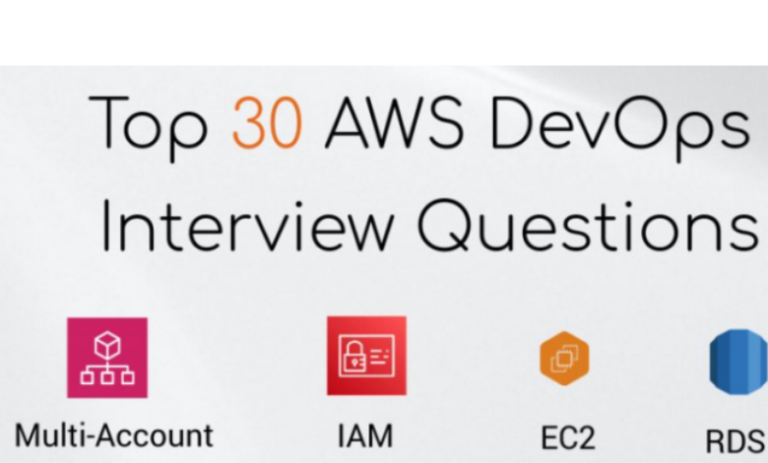AWS DevOps is a powerful combination of Amazon Web Services (AWS) and DevOps principles. This combination empowers organizations to build, deploy, and scale applications faster and more reliably. If you’re preparing for an AWS DevOps interview, it’s essential to be ready for a range of questions that test your technical skills, understanding of AWS services, and ability to implement DevOps practices. In this blog, we’ll cover some of the most common and challenging AWS DevOps interview questions to help you prepare effectively.
Whether you’re an experienced professional or just starting out, preparing for an AWS DevOps interview can be challenging. This guide will walk you through some of the most important questions you may encounter during an AWS DevOps interview, helping you feel more confident and prepared.
Top AWS Devops Interview Questions
What is AWS DevOps?
Answer: AWS DevOps refers to a set of practices, tools, and services that enable organizations to automate and streamline software development and IT operations processes using Amazon Web Services. It includes a wide range of AWS services, such as AWS CodePipeline, AWS CodeBuild, AWS CodeDeploy, and AWS CodeStar, that help teams implement DevOps practices like continuous integration and continuous delivery (CI/CD), infrastructure as code (IaC), monitoring, and logging.
What are the key components of AWS DevOps?
Answer: The key components of AWS DevOps include:
- AWS CodePipeline: A continuous integration and continuous delivery service for fast and reliable application updates.
- AWS CodeBuild: A fully managed build service that compiles source code, runs tests, and produces software packages.
- AWS CodeDeploy: A service that automates application deployment to Amazon EC2 instances, on-premises servers, or AWS Lambda.
- AWS CodeStar: A unified user interface that simplifies software development and DevOps workflows.
- AWS CloudFormation: Allows users to model and set up AWS resources using infrastructure as code.
- AWS Elastic Beanstalk: An easy-to-use service for deploying and managing applications in the AWS Cloud.
- AWS OpsWorks: A configuration management service that provides managed instances of Chef and Puppet.
What is Infrastructure as Code (IaC) and how does AWS support it?
Answer: Infrastructure as Code (IaC) is a practice in DevOps where infrastructure is provisioned and managed using code and software development techniques, such as version control and continuous integration. AWS supports IaC through services like AWS CloudFormation and AWS CDK (Cloud Development Kit).
- AWS CloudFormation: Enables you to define and provision AWS infrastructure using simple text files (templates) in JSON or YAML format.
- AWS CDK: A software development framework that allows you to define your cloud infrastructure using familiar programming languages like TypeScript, JavaScript, Python, Java, and C#.
Recommend To Read Also: Software Testing Course with Placement
What is the significance of CI/CD in AWS DevOps?
Answer: CI/CD is a critical practice in AWS DevOps that stands for Continuous Integration and Continuous Delivery/Deployment. The significance lies in its ability to:
- Continuous Integration (CI): Automatically integrate code changes from multiple developers into a shared repository several times a day, reducing integration issues and bugs.
- Continuous Delivery (CD): Automatically build, test, and prepare code for release to production, ensuring that software can be reliably released at any time.
- Continuous Deployment: Extends Continuous Delivery by automatically deploying code changes to production environments.
AWS offers a suite of tools (like AWS CodePipeline, AWS CodeBuild, and AWS CodeDeploy) that enable teams to implement and automate CI/CD processes.
How do you handle security in AWS DevOps?
Answer: Security in AWS DevOps can be handled through several practices:
- IAM (Identity and Access Management): Implementing least privilege access controls using IAM policies, roles, and groups.
- Encryption: Utilizing encryption for data at rest (e.g., AWS KMS) and in transit (e.g., SSL/TLS).
- Automated Security Checks: Integrating security checks into the CI/CD pipeline using tools like AWS Config, Amazon Inspector, and third-party tools.
- Audit and Monitoring: Setting up audit trails with AWS CloudTrail and continuous monitoring with Amazon CloudWatch and AWS Security Hub.
- Secret Management: Storing and managing secrets, such as API keys and passwords, using AWS Secrets Manager or AWS Systems Manager Parameter Store.
What is AWS CodePipeline, and how does it work?
Answer: AWS CodePipeline is a fully managed continuous delivery service that automates the build, test, and deploy phases of your release process every time there is a code change. It orchestrates the flow of your application’s source code through the various stages of your CI/CD pipeline.
- Stages: CodePipeline is composed of stages such as Source, Build, Test, and Deploy. Each stage consists of a series of actions, like fetching source code, running build commands, performing tests, or deploying code.
- Integrations: It integrates with other AWS services (like S3, CodeBuild, CodeDeploy, Lambda) and third-party tools (like GitHub, Jenkins).
What is Blue-Green Deployment, and how can it be implemented in AWS?
Answer: Blue-Green Deployment is a technique for releasing applications by gradually transferring user traffic from an old version of an application (Blue) to a new version (Green). This method ensures minimal downtime and rollback capabilities in case of issues.
In AWS, Blue-Green Deployment can be implemented using:
- AWS Elastic Beanstalk: Supports Blue-Green Deployment natively by creating a new environment and swapping CNAMEs.
- AWS CodeDeploy: Allows traffic splitting and gradual traffic shifting between two application versions on Amazon EC2 instances.
- Amazon Route 53: Can be used to switch traffic between two different environments by updating DNS records.
How do you implement monitoring and logging in AWS DevOps?
Answer: Monitoring and logging are essential components of AWS DevOps. Here’s how they can be implemented:
- Amazon CloudWatch: Used for monitoring AWS resources and applications. It collects and tracks metrics, sets alarms, and automatically reacts to changes in your AWS resources.
- AWS CloudTrail: Logs API calls made on your AWS account, providing visibility into user activities, which is crucial for auditing and compliance.
- AWS X-Ray: Helps in analyzing and debugging production applications by tracing requests made through your application.
- Centralized Logging: Aggregating logs from different services using AWS services like Amazon CloudWatch Logs or third-party tools like ELK (Elasticsearch, Logstash, Kibana) stack.
What is AWS Elastic Beanstalk, and how does it fit into DevOps?
Answer: AWS Elastic Beanstalk is a fully managed service that makes it easy to deploy and manage applications in the AWS Cloud. You simply upload your application code, and Elastic Beanstalk automatically handles the deployment, from capacity provisioning, load balancing, and auto-scaling to application health monitoring.
In a DevOps context, Elastic Beanstalk fits well as it allows developers to focus on writing code while AWS manages the infrastructure. It also integrates with CI/CD pipelines, making it easier to deploy and roll back application versions quickly.
How does AWS OpsWorks support DevOps practices?
Answer: AWS OpsWorks is a configuration management service that provides managed instances of Chef and Puppet, automation platforms that allow you to automate how servers are configured, deployed, and managed across your Amazon EC2 instances or on-premises environments.
- Configuration Management: Automates the setup, configuration, and maintenance of servers and software.
- Automated Deployments: Supports the automation of application deployments, patch management, and configuration updates.
- Version Control: Manages configurations and scripts in version-controlled repositories, ensuring consistent environment configurations.
Explain how you would set up a CI/CD pipeline using AWS services.
Answer: To set up a CI/CD pipeline using AWS services, follow these steps:
Source Stage: Store your source code in AWS CodeCommit or GitHub.
Build Stage (AWS CodeBuild): Use AWS CodeBuild to compile the code, run tests, and create build artifacts.
Test Stage: Run unit tests or other automated tests using AWS CodeBuild.
Deploy Stag: Deploy the build artifacts to your environment using AWS CodeDeploy or AWS Elastic Beanstalk.
Approval Stage : Optionally, add a manual or automated approval stage before production deployment.
Monitor Stage : Set up monitoring for deployment success and failure using Amazon CloudWatch.
The pipeline is managed and orchestrated using AWS CodePipeline, which automates the entire process from code commit to deployment.
What is Amazon EKS, and how is it used in AWS DevOps?
Answer: Amazon EKS (Elastic Kubernetes Service) is a managed Kubernetes service that makes it easy to run Kubernetes on AWS without needing to install and operate your own Kubernetes control plane.
In AWS DevOps, Amazon EKS is used to deploy, manage, and scale containerized applications using Kubernetes. It integrates with AWS services such as Elastic Load Balancing for load distribution, IAM for access control, and Amazon ECR for container image storage.
What is Amazon ECS, and how does it compare to EKS?
Answer: Amazon ECS (Elastic Container Service) is a fully managed container orchestration service that allows you to run Docker containers on a managed cluster of Amazon EC2 instances.
Comparison with EKS:
- Ease of Use: ECS is simpler to use as it abstracts much of the underlying Kubernetes complexity.
- Management: EKS is a managed Kubernetes service, offering more flexibility and control but requiring more configuration compared to ECS.
- Integration: Both services integrate with AWS services, but ECS offers tighter integration with AWS services, whereas EKS provides more flexibility for custom Kubernetes solutions.
How would you automate infrastructure provisioning in AWS?
Answer: Infrastructure provisioning in AWS can be automated using:
- AWS CloudFormation: Define your infrastructure in code (YAML or JSON templates), and use CloudFormation to create and manage a collection of related AWS resources, provisioning and updating them in an orderly and predictable fashion.
- AWS CDK: Use familiar programming languages (like Python, TypeScript, or Java) to define your cloud resources, then deploy them using AWS CDK.
- Terraform: Although not an AWS service, Terraform by HashiCorp is a popular tool for automating infrastructure provisioning across various cloud providers, including AWS.
These tools allow you to manage infrastructure as code, making it easier to version control, automate, and replicate environments.
What is AWS Lambda, and how does it fit into a DevOps strategy?
Answer: AWS Lambda is a serverless compute service that lets you run code without provisioning or managing servers. You pay only for the compute time you consume, which makes it cost-effective for short-lived tasks.
Recommend To Read Also: Quality Assurance Tester Certification
In a DevOps strategy, AWS Lambda fits in by:
- Automation: Automating tasks like backups, log processing, and real-time file processing.
- Microservices: Building microservices architectures where each service is a separate Lambda function.
- CI/CD Pipelines: Running lightweight, event-driven tasks such as code linting, testing, and deploying components in a CI/CD pipeline.
Conclusion
Preparing for an AWS DevOps interview requires a strong understanding of both AWS services and DevOps practices. The questions covered in this guide offer a comprehensive overview of what you might encounter in an interview. By mastering these topics, you’ll be well-equipped to demonstrate your expertise and readiness for a role in AWS DevOps.
Remember, while technical knowledge is critical, demonstrating an understanding of how these services and practices fit into a broader business and development strategy will set you apart from other candidates. Happy interviewing!




























